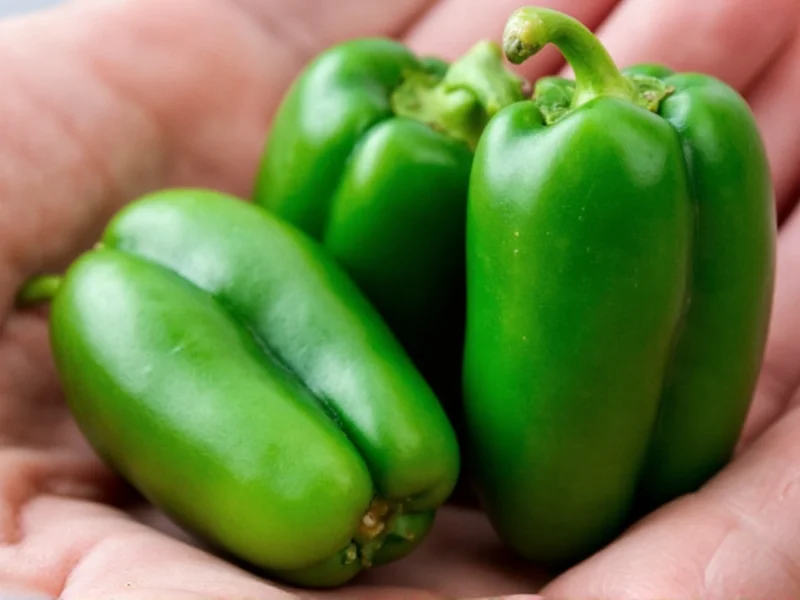Understanding the heat difference between poblano peppers and jalapeños is essential for home cooks and culinary professionals alike. These two popular chili peppers often appear in similar recipes but deliver dramatically different heat experiences. The Scoville Scale, which measures capsaicin concentration, provides the definitive comparison between these peppers' spiciness levels.
Scoville Scale Explained
Developed by pharmacist Wilbur Scoville in 1912, the Scoville Scale measures the concentration of capsaicin—the compound responsible for chili pepper heat. Originally determined through human taste testing, modern measurements use high-performance liquid chromatography for precise results. The scale ranges from 0 SHU (bell peppers) to over 2 million SHU (Carolina Reaper).
Poblano Pepper Heat Profile
Poblanos, named after their origin in Puebla, Mexico, are large, dark green peppers that turn red when mature. Fresh poblanos register between 1,000-2,000 SHU on the Scoville Scale. When dried, they become ancho peppers, maintaining similar heat levels but developing a richer, smokier flavor profile. Poblanos offer an earthy, slightly sweet taste with minimal heat that most palates find approachable.
Jalapeño Pepper Heat Profile
Jalapeños, originating from Xalapa, Mexico, typically measure 2,500-8,000 SHU—making them significantly hotter than poblanos. Their heat can vary considerably based on growing conditions, with stress factors like water scarcity increasing capsaicin production. Jalapeños provide a bright, grassy flavor with noticeable heat that builds gradually. The seeds and white membranes contain the highest concentration of capsaicin, so removing these reduces heat substantially.
Direct Heat Comparison
| Pepper Type | Scoville Heat Units | Heat Relative to Poblano | Flavor Profile | Common Culinary Uses |
|---|---|---|---|---|
| Poblano | 1,000-2,000 SHU | 1x (baseline) | Earthy, mild, slightly sweet | Chiles Rellenos, mole sauce, stuffed peppers |
| Jalapeño | 2,500-8,000 SHU | 2.5-8x hotter | Grassy, bright, noticeably spicy | Salsas, nachos, pickled peppers, guacamole |
Culinary Implications of Heat Differences
The substantial heat gap between these peppers significantly impacts recipe outcomes. Substituting one for the other without adjustment can dramatically alter a dish's flavor profile. Poblanos work well in dishes where pepper flavor should shine without overwhelming heat, such as stuffed peppers or creamy sauces. Their mild nature makes them ideal for introducing children to chili peppers.
Jalapeños provide the signature heat in many Mexican and Tex-Mex dishes. Their higher capsaicin content means they're better suited for recipes where noticeable spice is desired. When using jalapeños in place of poblanos, consider removing seeds and membranes or using fewer peppers to maintain similar heat levels.
Factors Affecting Heat Levels
Several variables influence the actual heat you'll experience with both peppers:
- Growing conditions: Drought-stressed plants produce hotter peppers
- Ripeness: Red (mature) jalapeños are often hotter than green ones
- Individual variation: Heat can differ between peppers on the same plant
- Preparation method: Removing seeds and membranes reduces heat significantly
Practical Substitution Guidance
When substituting between these peppers:
- To replace poblano with jalapeño: Use half the amount of jalapeño and remove seeds/membranes
- To replace jalapeño with poblano: Use 2-3 times more poblano for similar heat impact
- For poblano's earthy flavor without heat: Consider using bell peppers with smoked paprika
- For jalapeño's bright heat: Serrano peppers offer similar flavor at 10,000-23,000 SHU
Common Misconceptions
Several myths persist about these peppers' heat levels:
- Myth: All jalapeños are extremely hot
Reality: Many commercial jalapeños are bred for milder heat (around 2,500 SHU) - Myth: Poblanos are completely mild
Reality: Some can reach the lower end of jalapeño heat, especially when stressed - Myth: Color determines heat level
Reality: While red jalapeños are often hotter, color alone isn't a reliable heat indicator
Safety Tips for Handling Hotter Peppers
When working with jalapeños (or hotter varieties), follow these safety precautions:
- Wear gloves to prevent capsaicin transfer to sensitive areas
- Avoid touching your face while handling hot peppers
- Wash hands thoroughly with soap after preparation
- Use separate cutting boards for hot peppers
- If experiencing burning sensation, use dairy products (milk, yogurt) rather than water
Conclusion
Understanding the heat difference between poblano peppers and jalapeños—approximately 2-8 times hotter for jalapeños—empowers cooks to make informed decisions in the kitchen. This poblano vs jalapeno heat comparison reveals why these peppers serve different culinary purposes despite their visual similarities. Whether you're preparing a mild stuffed pepper dish or a spicy salsa, selecting the appropriate pepper based on its Scoville rating ensures your recipe achieves the intended flavor profile. Remember that individual pepper heat can vary, so always taste a small piece before committing to a recipe.
Frequently Asked Questions
Can I substitute poblano for jalapeño in recipes?
Yes, but you'll need to adjust quantities. Since jalapeños are 2-8 times hotter than poblanos, use 2-3 times more poblano to achieve similar heat. For recipes where heat is essential (like spicy salsas), consider adding a pinch of cayenne pepper along with the poblano to compensate for the lower heat level.
Why do some jalapeños taste much hotter than others?
Jalapeño heat varies due to growing conditions—peppers stressed by drought or poor soil produce more capsaicin. The specific cultivar, ripeness (red jalapeños are often hotter), and even position on the plant affect heat levels. The seeds and white membranes contain the highest capsaicin concentration, so peppers with more of these internal structures will be hotter.
Are poblano peppers the same as pasilla peppers?
No, though confusion exists. Fresh poblanos are large, heart-shaped peppers. When dried, they become ancho peppers. Pasilla peppers are actually dried chilaca peppers, which are longer and thinner than poblanos. Pasillas typically measure 1,000-2,500 SHU—similar to poblanos but with a fruitier flavor profile.
How can I reduce the heat of jalapeños without losing flavor?
Remove the seeds and white membranes (placenta), which contain most capsaicin, while retaining the flavorful flesh. Roasting jalapeños can also mellow their heat while enhancing sweetness. For significant heat reduction, soak sliced jalapeños in milk or buttermilk for 15-30 minutes before use, as dairy proteins bind to capsaicin.











 浙公网安备
33010002000092号
浙公网安备
33010002000092号 浙B2-20120091-4
浙B2-20120091-4